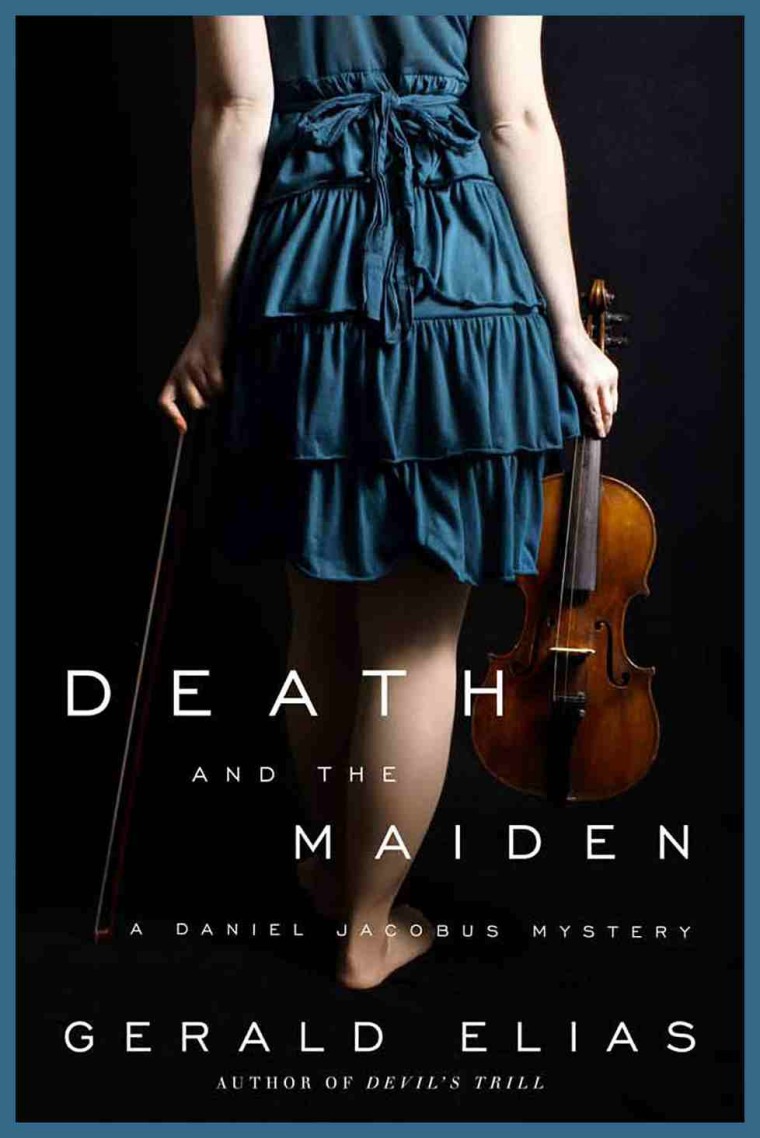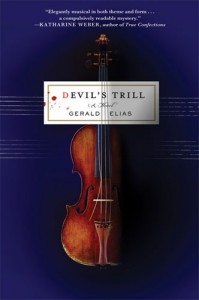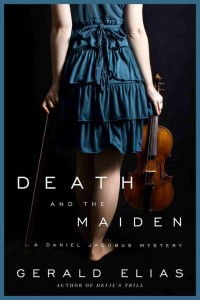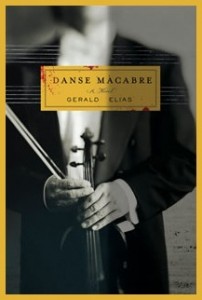An Interview with Gerald Elias, Violinist and Author
Ann Drinan: I know you’ve just spent the summer at Tanglewood. Where will your book tour take you?
Gerald Elias: To Philadelphia, Pittsburgh, Baltimore, Oxford Mississippi, Houston, Scottsdale, and many more cities. For my previous books, I didn’t have time to do as long a book tour because I always I had to get back to Salt Lake City from the Berkshires for the beginning of the Utah Symphony season.
AD: And this year you do have time because…
GE: I retired from the Utah Symphony last May. My fourth book, Death and Transfiguration, is already in the editing phase, and will be released next June, so I’ll be able to do another tour then.
AD: How did you get interested in mystery novels?
GE: I’m retelling my experiences over the past 35 years in a form that I’ve always enjoyed reading. It’s been a real creative experience for me.
I have an older brother and sister; when I was a kid, my brother had all the Hardy Boys adventures and my sister had all the Nancy Drew series. I’ve always found reading mysteries to be a very relaxing and entertaining escape.
AD: Who are some of your favorite mystery writers?
GE: Some of my favorites include John LeCarré; Donna Leon, who has written a series of crime novels set in Venice that are very evocative of the city; Walter Mosley; and Dick Francis – I really admire the skill he has used to hone his template.
AD: What made you decide to start writing a novel?
GE: I’ve written for pleasure since I was a kid. I never had anything published, but I enjoyed writing essays for homework assignments, and doing creative writing exercises in high school. It’s always been something that came naturally to me, even though I never considered the possibility of being a serious professional writer.
When I first began writing Devil’s Trill, I had no idea where it would lead. That book started out primarily for my own students – I wanted to write about the challenges, both technically and career-wise, that young musicians encounter.In fact, it was first called Violin Lessons. To make it entertaining, I wove the story around a stolen Stradivarius. I started writing Devil’s Trill in 1997, it went through lots of rewrites, and ultimately it became transformed into a traditional “who done it.”
AD: Tell me about your main characters: Daniel Jacobus, a blind violin teacher who’s basically a hermit in the Berkshires; Nathaniel Williams, a former ‘cellist who is a renowned insurance investigator into fine instrument fraud; and Yumi, Jacobus’ best student.
GE: All the characters are composites. A few, like Nathaniel Williams, are more or less a replica of someone I know in real life. Jacobus or Jake, as his few friends know him, is the most complex composite; he’s the one who really has no direct correspondence in real life. He’s truly a fictional character.
When I first conjured him up, I didn’t have much of a biography as to why he is the way he is. But over the course of the four books, we learn more and more about why he acts the way he does.
AD: Is Yumi based on one of your students?
GE: I’ve been teaching for about 40 years and I know how students and former students respond to instruction. She is a real composite character. I’ve been to Japan many times on tour, and I lived there for five months in 1987. There are some personality traits of people I know there that I imbued in Yumi.
AD: Your books have a lot of violence in them – some of it perhaps a bit “over the top.”
GE: I don’t start out seeking violence in a book,and I try to keep it to a minimum, but murder is murder, and in a mystery, there needs to be something creative about it. Another of my favorite mystery writers is Lawrence Sanders, who wrote the Seven Deadly Sin series – he came up with very novel ways of people getting offed!
AD: How do you create your villains?
Jacobus’ manner of teaching Yumi is extremely harsh but it’s the old school: if you can get through this, then you can get through anything. It’s sort of like being in the Marines and going through boot camp. The positive thing is that she did appreciate him for what he did, and they created a strong and enduring bond. One my friends referred to them [Jake, Nathaniel, and Yumi] as the Mod Squad!
AD: You’ve just published your third book, Death and the Maiden. Tell us about it.
GE: The concept of the third book came from Schubert’s quartet and song of the same name. For each book I use the title of a piece of classical music that deals with death. I got the idea of having a quartet where each member disappears, then I drew upon not only the music from the string quartet but also the song Schubert wrote, which deals with the concept of when am I going to be approached by death. When will my moment arrive? Building on that point, I played with the notion of when that moment does arrive, will I struggle to live another minute, day or year, or will I bow out graciously? That’s a question that’s central to the book, especially the climax. The music and the text were both very motivating.
To have this quartet that’s disintegrating from within perform the piece as a do-or-die moment in their careers seemed to jibe very nicely.
The situation of the quartet in my book really has parallels in real life with the tribulations of the Audubon String Quartet. I myself auditioned for that position in the quartet [first violin] a few years before the other guy, who was fired and sued, got it. I wonder how everyone’s lives would be different today if I had gotten that position. [Click here for a summary of the Audubon Quartet’s legal problems.]
By the way, the legal fees of the guy who won the suit were so high that,my understanding is, he didn’t benefit from the legal suit either – lose-lose all around.
AD: What was the genesis of the scene with the older Russian musicians and the Circle of Fifths drinking scene?
GE: I’ve had so many wonderful Russian colleagues, both in Boston and Utah – I’m indebted to them for all their stories and their personalities. I amalgamated them into the book’s original string quartet – some were stories they told me shortly after they arrived from the former Soviet Union. For example, the mother of a violist colleague came to visit after he’d been in America for a few years. He took her to the Star Market in Boston and she passed out. She couldn’t believe that there was all this food!
I tried to take some of those stories and put them into the characters to give them that air of the reality of that time.
Some who have read the books say that the characters verge on becoming caricatures, but they must not have ever met exuberant Russians, especially after a few vodkas! One of our guest conductors in Utah, Pavel Kogan, was a terrific and exciting musician, and he wore his heart on his sleeve. He’s the one I got the experience of being whopped on the back from.
I made up the Circle of Fifths drinking game. That chapter was the one I’ve most enjoyed writing. There are hints about everything in the plot that come out later, and lots of information that gets intentionally blurred over because they’re in a drunken haze. Some of the comments between Lensky and Jacobus aver to what’s really going on with my fictional quartet.
AD: What’s your writing process been like over the course of the three books?
GE: Devil’s Trill took me about ten years from when I sat down to write to when it was in print. People have asked me how I could be so patient to rewrite over and over again and not get frustrated. My response is that I’m a musician, and there’s music I started to learn when I was in high school – Bach sonatas and the Beethoven concerto, and I’m still working on them 40 years later to make them better. So the fact that it took ten years doesn’t seem like a very long time. The proof is that I wrote the next couple of books in a year and a half each. There are lots of similarities between writing and playing music, in terms of the skills involved. It’s not as if I’m embarking on a totally different career – it’s more or less a continuation of the same kind of creative process; I’m just redirecting it.
Many of my BSO and Utah Symphony colleagues have been eagerly waiting the fourth book in the series, Death and Transfiguration, because in that one, the conductor gets murdered. My contract with St. Martin’s Press is for four books – they may extend it if they’re happy with the sales. But I also have some ideas about other books, going in a different direction.
AD: How have sales been? Do your books appeal only to people who know the classical music world?
GE: The first two books sold well enough to keep St. Martin’s happy. The third has only been out a few weeks, so the jury’s still out on that one.
Since the books take place in the classical music world, people who know that world will nod their heads and understand. But I also believe that someone who knows nothing about classical music will also enjoy them. [In addition, anyone who goes to my website (www.geraldelias.com) can click on the icon on my Murder To Die For page and listen to a live performance of any of the music in the books.
Look at the books of Dick Francis – I’ve never been to an English racetrack but when I read his books, I feel a part of that world. His work sets the bar very high.
AD: How much did your own teaching experience come into the Jacobus character?
GE: I’ve had very close relationships with many of my students and past students – I follow them through their careers and try to be more than just someone who teaches them where to put their fingers on the instrument. It’s a real commitment. The reward is seeing the light bulb go on when I’m teaching them – when I communicate something they didn’t understand both conceptually and physically, and they can suddenly do it and sound better immediately. The look on their faces is the real reward for me. I imparted that to Jacobus, though I don’t agree with everything he says and how he says it. I focused on the moments when Yumi can tell how deeply he really feels about her – she knows he won’t compliment someone lightly.
AD: How about your own teachers?
GE: I remember when I was a student of the legendary Ivan Galamian for four years. During my last year, when I was a senior in high school preparing for college auditions, I went into a lesson and brought along my first teacher, William Liva from Long Island. I had been practicing the Mendelssohn Concerto like crazy, and when I finished playing it at the lesson, Galamian looked at Mr. Liva and said, “Not bad.” For me it was like I’d been given a gold medal, because I knew a few words like that from him were high praise.
Joseph Silverstein was terrific – he has perfected the art of playing with the greatest mechanical efficiency of anyone I know. He gets the best result with the least amount of physical stress. When you’re talking about a career – a lifetime – it’s extremely important to know how to use the natural weight of your arm to create a beautiful projecting sound without damaging your muscles. He opened up a new avenue of thought for me. Combined with what I learned from Galamian, he really helped me over the years.
AD: Best of luck to you, Jerry, in your new career and we’ll all look forward to the release of the fourth book in the Daniel Jacobus series.





No comments yet.
Add your comment